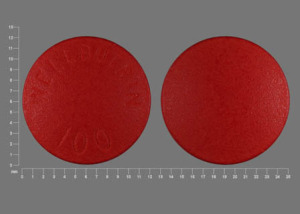Wellbutrin Tablets Dosage
Generic name: BUPROPION HYDROCHLORIDE 100mg
Dosage form: tablet, film coated
Drug class: Miscellaneous antidepressants
Medically reviewed by Drugs.com. Last updated on Apr 17, 2024.
General Instructions for Use
To minimize the risk of seizure, increase the dose gradually [see Warnings and Precautions (5.3)]. WELLBUTRIN SR tablets should be swallowed whole and not crushed, divided, or chewed. WELLBUTRIN SR may be taken with or without food.
The usual adult target dose for WELLBUTRIN SR is 300 mg per day, given as 150 mg twice daily. Initiate dosing with 150 mg per day given as a single daily dose in the morning. After 3 days of dosing, the dose may be increased to the 300-mg-per-day target dose, given as 150 mg twice daily. There should be an interval of at least 8 hours between successive doses. A maximum of 400 mg per day, given as 200 mg twice daily, may be considered for patients in whom no clinical improvement is noted after several weeks of treatment at 300 mg per day. To avoid high peak concentrations of bupropion and/or its metabolites, do not exceed 200 mg in any single dose.
It is generally agreed that acute episodes of depression require several months or longer of antidepressant drug treatment beyond the response in the acute episode. It is unknown whether the dose of WELLBUTRIN SR needed for maintenance treatment is identical to the dose that provided an initial response. Periodically reassess the need for maintenance treatment and the appropriate dose for such treatment.
Dose Adjustment in Patients with Hepatic Impairment
In patients with moderate to severe hepatic impairment (Child-Pugh score: 7 to 15), the maximum dose of WELLBUTRIN SR is 100 mg per day or 150 mg every other day. In patients with mild hepatic impairment (Child-Pugh score: 5 to 6), consider reducing the dose and/or frequency of dosing [see Use in Specific Populations (8.7), Clinical Pharmacology (12.3)].
Dose Adjustment in Patients with Renal Impairment
Consider reducing the dose and/or frequency of WELLBUTRIN SR in patients with renal impairment (Glomerular Filtration Rate less than 90 mL per min) [see Use in Specific Populations (8.6), Clinical Pharmacology (12.3)].
Switching a Patient to or from a Monoamine Oxidase Inhibitor (MAOI) Antidepressant
At least 14 days should elapse between discontinuation of an MAOI intended to treat depression and initiation of therapy with WELLBUTRIN SR. Conversely, at least 14 days should be allowed after stopping WELLBUTRIN SR before starting an MAOI antidepressant [see Contraindications (4), Drug Interactions (7.6)].
Use of WELLBUTRIN SR with Reversible MAOIs Such as Linezolid or Methylene Blue
Do not start WELLBUTRIN SR in a patient who is being treated with a reversible MAOI such as linezolid or intravenous methylene blue. Drug interactions can increase the risk of hypertensive reactions. In a patient who requires more urgent treatment of a psychiatric condition, non-pharmacological interventions, including hospitalization, should be considered [see Contraindications (4), Drug Interactions (7.6)].
In some cases, a patient already receiving therapy with WELLBUTRIN SR may require urgent treatment with linezolid or intravenous methylene blue. If acceptable alternatives to linezolid or intravenous methylene blue treatment are not available and the potential benefits of linezolid or intravenous methylene blue treatment are judged to outweigh the risks of hypertensive reactions in a particular patient, WELLBUTRIN SR should be stopped promptly, and linezolid or intravenous methylene blue can be administered. The patient should be monitored for 2 weeks or until 24 hours after the last dose of linezolid or intravenous methylene blue, whichever comes first. Therapy with WELLBUTRIN SR may be resumed 24 hours after the last dose of linezolid or intravenous methylene blue.
The risk of administering methylene blue by non-intravenous routes (such as oral tablets or by local injection) or in intravenous doses much lower than 1 mg per kg with WELLBUTRIN SR is unclear. The clinician should, nevertheless, be aware of the possibility of a drug interaction with such use [see Contraindications (4), Drug Interactions (7.6)].
Frequently asked questions
- Does Wellbutrin XL/SR cause weight gain or loss?
- Can I stop taking Wellbutrin suddenly or should I taper off?
- How long does it take Wellbutrin XL/SR (bupropion) to work?
- What's the difference between Wellbutrin XL and SR?
- Does Auvelity work better than Wellbutrin?
- Auvelity vs. Wellbutrin: Effectiveness for Depression?
More about Wellbutrin (bupropion)
- Check interactions
- Compare alternatives
- Reviews (750)
- Drug images
- Side effects
- Dosage information
- Patient tips
- During pregnancy
- Generic availability
- Support group
- Drug class: miscellaneous antidepressants
- Breastfeeding
Patient resources
Other brands
Zyban, Aplenzin, Forfivo XL, Budeprion SR, ... +2 more
Professional resources
Other brands
Other formulations
Related treatment guides
Further information
Always consult your healthcare provider to ensure the information displayed on this page applies to your personal circumstances.


